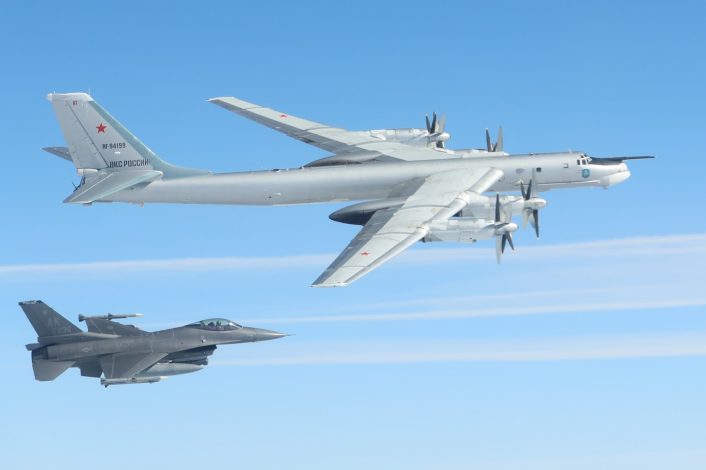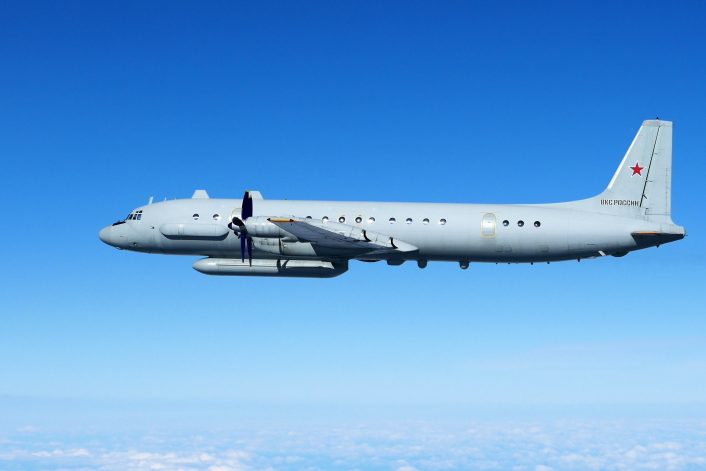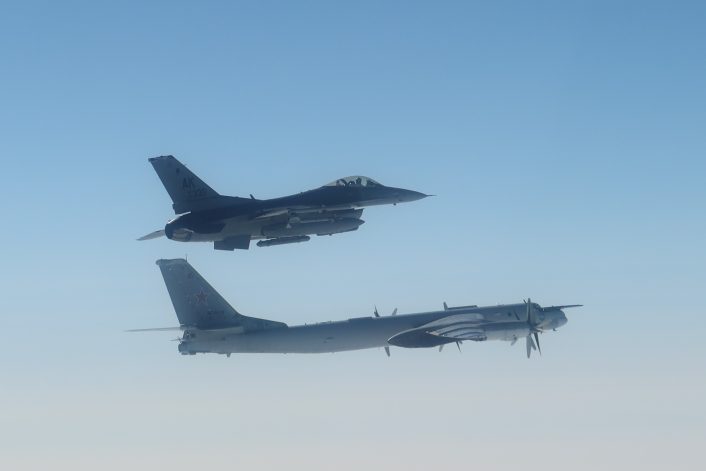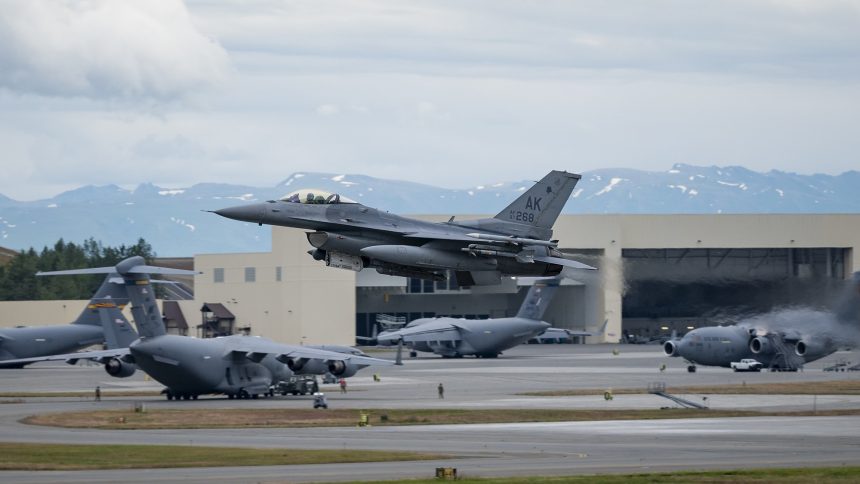NORAD scrambled U.S. Air Force F-16s to intercept Russian Il-20 surveillance aircraft three times in the Alaskan ADIZ in less than one week.
The North American Aerospace Defense Command (NORAD) reported three separate intercepts of Russian Il-20 “Coot” surveillance aircraft operating inside the Alaskan Air Defense Identification Zone (ADIZ) between Aug. 20 and Aug. 24, 2025. While such intercepts are not uncommon, the frequency of three within a five-day span has drawn attention, particularly amid heightened geopolitical tensions and major U.S.-led military exercises in the region, such as Northern Edge 2025.
The consecutive encounters also came just few days after the meeting between U.S. President Donald Trump and Russian President Vladimir Putin on Aug. 15 at Joint Base Elmendorf-Richardson, Alaska. As in other occasions, the Russian aircraft remained in international airspace without violating the airspace of the United States or Canada.
According to NORAD press releases, each of the three flights was detected and monitored by NORAD’s layered defense system, which employs satellites, airborne and ground-based radars, and fighter aircraft to provide continuous airspace awareness. Together with F-16s, NORAD also scrambled a support package of KC-135 tankers and E-3 AWACS aircraft.
CACHE 50 (E-3 AWACS) launched from Elmendorf AFB just after 2000z this afternoon and was last seen approaching the Chukchi Sea about 40 minutes ago. Looks like another Ru AF flight skirting the ADIZ today.
Audio via @liveatc and tracking via @flightradar24 https://t.co/Ch5ZShJvgg pic.twitter.com/W4l4iWwKQF
— Thenewarea51 (@thenewarea51) August 25, 2025
The Alaskan ADIZ and NORAD’s Role
An Air Defense Identification Zone, or ADIZ, is a stretch of international airspace beyond national sovereign territory in which the ready identification of all aircraft is required for national security purposes. The Alaskan ADIZ borders the Russian easternmost region, making it one of the busiest zones for U.S. and allied air defense forces.
Unlike national airspace, which is sovereign and extends 12 nautical miles beyond a country’s coast, ADIZs are not bound by international law but are critical for national security. Any aircraft entering without proper clearance is subject to interception by fighter aircraft on Quick Reaction Alert (QRA).
NORAD, the bi-national U.S.-Canadian command headquartered at Peterson Space Force Base, Colorado, is tasked with defending North America’s airspace. The command regularly monitors Russian long-range aviation flights, including Tu-95 bombers and fighter escorts, but the recent series of Il-20 flights represents a relatively rarer appearance of Russian electronic intelligence-gathering aircraft in the region.

Aug. 20 Intercept
On Aug. 20, 2025, NORAD detected and tracked a Russian Il-20 operating in the Alaskan ADIZ, according to an official press release. In response, NORAD launched two F-16 Fighting Falcons supported by a KC-135 Stratotanker from Eielson Air Force Base, Alaska. The U.S. fighters intercepted and visually identified the Russian surveillance plane before escorting it until it exited the ADIZ.
The aircraft remained entirely in international airspace and did not cross into U.S. or Canadian sovereign territory, confirmed NORAD. According to a statement released by NORAD to Air & Space Forces Magazine, the Il-20 flew inside the ADIZ for approximately one hour and 12 minutes at a distance of around 25 nautical miles from Alaska’s St. Lawrence Island, located south of the Bering Strait and less than 50 miles from Russian territory.
NORAD reiterated that the flight was “not seen as a threat,” emphasizing that such activity occurs regularly and is consistent with long-standing Russian aerial patrol patterns. Contrary to other occasions, there were no reports of “unprofessional conduct” by the Russian aircraft.
Aug. 21 Intercept
Roughly 24 hours later, on Aug. 21, NORAD again tracked an Il-20 operating in the ADIZ. This time, NORAD scrambled two F-16s, a KC-135 tanker, and an E-3 Sentry Airborne Warning and Control System (AWACS) aircraft to intercept, visually identify, and monitor the Russian plane. It is not uncommon for an AWACS to be sent out in support of a QRA mission, as they can add another layer of surveillance to monitor the situation.
The Aug. 21 incursion lasted longer than the previous day’s flight. In fact, according to Air & Space Forces Magazine, this time the Il-20 remained in the ADIZ for over two hours, with its closest approach approximately 100 miles from Cape Lisburne, the northernmost point of Alaska.
Like the earlier incident, the aircraft never entered U.S. or Canadian sovereign airspace. Similarly, no incidents were noted during the interaction between the U.S. and Russian aircraft.
Aug. 24 Intercept
The third and most recent intercept occurred on Aug. 24, when NORAD tracked yet again an Il-20 in the Alaskan ADIZ. In this case, two F-16s, an E-3 AWACS, and two KC-135 Stratotankers were launched to monitor and visually identify the aircraft.
The Il-20 again remained in international airspace throughout the mission. NORAD noted in its press release that the Russian aircraft’s presence in the ADIZ was consistent with routine operations and posed no immediate threat.
However, the timing of the three incidents – occurring within five days – stands out compared to the usual pace of Russian flights in the region. Before this week, the last reported interception was in July 2025.
A legitimate doubt, after the three intercepts, is if the Russian Il-20 was always the same airframe. However, NORAD did not provide details on that, and the absence of photos doesn’t allow to independently verify it.

The Il-20
The intercepted aircraft in all three incidents was the Ilyushin Il-20, known by its NATO reporting name “Coot.” Unlike the Tu-95 strategic bombers that are more frequently intercepted near Alaska, the Il-20 is a specialized reconnaissance and electronic intelligence (ELINT) platform.
Equipped with an array of antennas, sensors, and signals intelligence equipment, the Il-20 is designed to gather electronic and communications intelligence. The type has been employed in various theaters, including Syria, where Russian Il-20s supported military operations and one was accidentally shot down by Syrian air defenses in 2018.
The appearance of the Il-20 in the Alaskan ADIZ is less common than bomber flights and may reflect ongoing intelligence-gathering missions amid broader geopolitical developments. As mentioned earlier, the Northern Edge 2025 exercise is currently ongoing and that would be a hard-to-pass target for data collection.
Exercises and Diplomacy
The series of intercepts coincided with large-scale U.S.-led military exercises in Alaska. Northern Edge, involving some 6,400 personnel, 100 aircraft, and seven ships – including the carrier USS Abraham Lincoln – was underway in the region at the same time. While NORAD did not confirm whether Russian aircraft were surveilling the exercise, the proximity in timing is notable.
As mentioned in the opening, the flights also occurred days after a summit at Joint Base Elmendorf-Richardson in Alaska between U.S. President Donald Trump and Russian President Vladimir Putin, during which the leaders discussed the war in Ukraine. Although no changes in military posture were announced, the back-to-back Il-20 flights are unusual for the region.

Also, while NORAD emphasized in each statement that the Russian flights posed no threat and remained entirely within international airspace, their frequency illustrates the continued importance of the Alaskan ADIZ as a focal point of U.S.-Russian military interaction. Such encounters are seen as both intelligence-gathering opportunities and demonstrations of strategic presence.
For NORAD, the incidents highlight the importance of readiness. With F-16s and F-35s at Eielson AFB and F-22 Raptors stationed at JBER, U.S. and Canadian forces maintain the ability to rapidly respond to incursions in the ADIZ as part of their mission to defend North American airspace. The importance of this aspect can be also seen by the redesignation of the 18th Aggressor Squadron as 18th Fighter Interceptor Squadron, with the F-16s now taking a bigger role in the air defense of Alaska.









